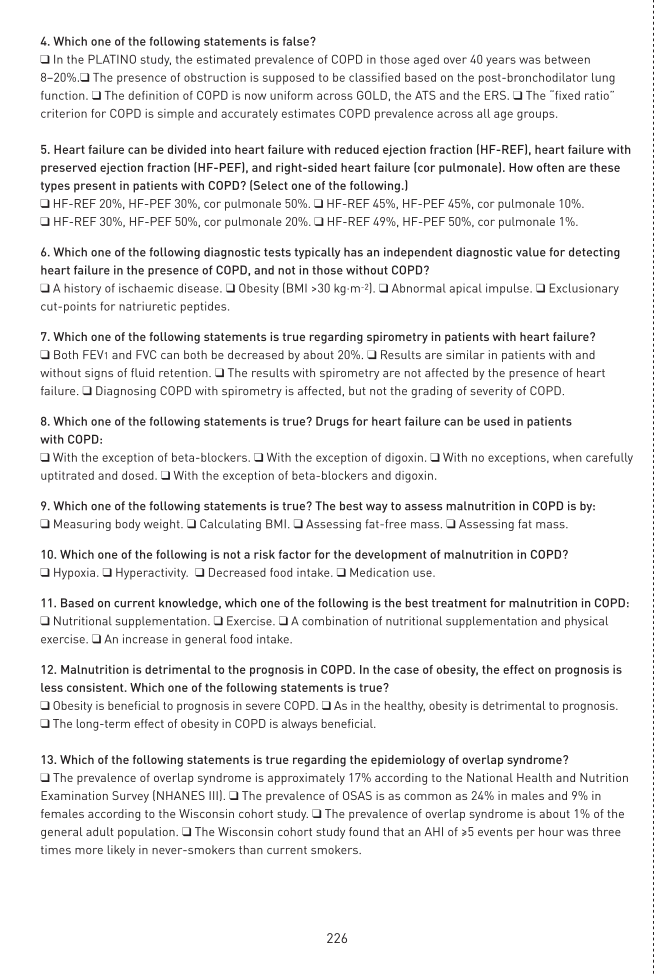4. Which one of the following statements is false? In the PLATINO study, the estimated prevalence of COPD in those aged over 40 years was between 8–20%. The presence of obstruction is supposed to be classified based on the post-bronchodilator lung function. The definition of COPD is now uniform across GOLD, the ATS and the ERS. The “fixed ratio” criterion for COPD is simple and accurately estimates COPD prevalence across all age groups. 5. Heart failure can be divided into heart failure with reduced ejection fraction (HF-REF), heart failure with preserved ejection fraction (HF-PEF), and right-sided heart failure (cor pulmonale). How often are these types present in patients with COPD? (Select one of the following.) HF-REF 20%, HF-PEF 30%, cor pulmonale 50%. HF-REF 45%, HF-PEF 45%, cor pulmonale 10%. HF-REF 30%, HF-PEF 50%, cor pulmonale 20%. HF-REF 49%, HF-PEF 50%, cor pulmonale 1%. 6. Which one of the following diagnostic tests typically has an independent diagnostic value for detecting heart failure in the presence of COPD, and not in those without COPD? A history of ischaemic disease. Obesity (BMI 30 kg·m-2). Abnormal apical impulse. Exclusionary cut-points for natriuretic peptides. 7. Which one of the following statements is true regarding spirometry in patients with heart failure? Both FEV1 and FVC can both be decreased by about 20%. Results are similar in patients with and without signs of fluid retention. The results with spirometry are not affected by the presence of heart failure. Diagnosing COPD with spirometry is affected, but not the grading of severity of COPD. 8. Which one of the following statements is true? Drugs for heart failure can be used in patients with COPD: With the exception of beta-blockers. With the exception of digoxin. With no exceptions, when carefully uptitrated and dosed. With the exception of beta-blockers and digoxin. 9. Which one of the following statements is true? The best way to assess malnutrition in COPD is by: Measuring body weight. Calculating BMI. Assessing fat-free mass. Assessing fat mass. 10. Which one of the following is not a risk factor for the development of malnutrition in COPD? Hypoxia. Hyperactivity. Decreased food intake. Medication use. 11. Based on current knowledge, which one of the following is the best treatment for malnutrition in COPD: Nutritional supplementation. Exercise. A combination of nutritional supplementation and physical exercise. An increase in general food intake. 12. Malnutrition is detrimental to the prognosis in COPD. In the case of obesity, the effect on prognosis is less consistent. Which one of the following statements is true? Obesity is beneficial to prognosis in severe COPD. As in the healthy, obesity is detrimental to prognosis. The long-term effect of obesity in COPD is always beneficial. 13. Which of the following statements is true regarding the epidemiology of overlap syndrome? The prevalence of overlap syndrome is approximately 17% according to the National Health and Nutrition Examination Survey (NHANES III). The prevalence of OSAS is as common as 24% in males and 9% in females according to the Wisconsin cohort study. The prevalence of overlap syndrome is about 1% of the general adult population. The Wisconsin cohort study found that an AHI of ≥5 events per hour was three times more likely in never-smokers than current smokers. 226
